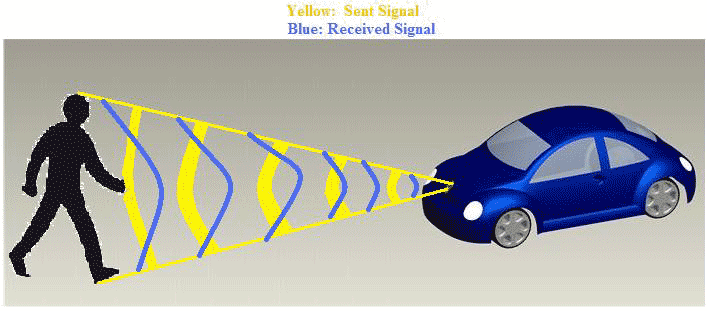Pedestrian Detection Systems
by Ahmad T. Mayyas, Clemson Automotive Engineering Graduate Student
- Basic Description
-
Motor vehicle accidents involving pedestrians are a problem throughout the world. In the United States, this problem is particularly serious. National Highway Traffic Safety Administration (NHTSA) statistics show that [1-2]:
- More than 4,000 pedestrians were killed in car accidents in 2009
- In 2009, about 59,000 pedestrians were injured; 13,000 of those injured people were of age 14 years and younger
- The statistics also show that 11% of motor vehicle fatalities involve pedestrians
- A pedestrian is hurt in a traffic accident every 8 minutes
- One pedestrian loses their life in a traffic accident every 2 hours.
For these reasons and more, safety systems in general and pedestrian safety systems in particular are attracting more attention. Since 2010, all Volvo S60 model cars have come with pedestrian detection systems. Volvo is producing the world's first pedestrian detection system with full braking capability.Volvo is currently the only manufacturer that offers this pedestrian-collision avoidance system, though Toyota has announced plans to introduce a similar system in the near future. The Volvo pedestrian detection system includes both radar and camera-based sensors that can detect pedestrians in front of the vehicle and warn the driver if someone walks out into vehicle path. Depending on the driver response and the car speed, either a full brake will be applied automatically (for speeds less than 35km/hr) or the speed will be reduced as much as possible (for speed above 35km/hr). The system can detect pedestrians who are 80 cm tall and upwards.
Statistics reveal that the speed of the vehicle has significant importance in the resulting injuries. At low speeds, the risk of serious injuries is significantly reduced. For example, if the speed is cut down from 50 km/hr to 25 km/hr, the pedestrian detection with full auto brake is expected to reduce the fatality risk by 20% and in some cases by up to 85%.

Pedestrian detection with full auto brake consists of a radar sensor integrated into the vehicle's grille, a camera fitted in front of the interior rear-view mirror, and a central control unit. The radar detects any object in front of the car and determines the distance between the car and that object. The camera determines what kind of object it is. The dual-mode radar in the Volvo S60 has a much wider field of vision that can detect pedestrians who are about to step into the roadway. The camera has higher resolution and has the ability to detect a pedestrian's pattern of motion. The auto-brake system can apply the full brake if the image is confirmed by the both the radar and the camera. In an emergency situation where a pedestrian steps into the roadway, the driver first receives an audible warning in association with a flashing light in the windshield's head-up display. If the driver does not react to the audible warning and an accident is about to happen, full braking power is automatically applied. However, this system has some limitations as it has limited imaging capabilities in the dark or in bad weather conditions.
A similar system without full braking called an advanced pre-collision system is available in Lexus vehicles. This is basically a driver attention system that designed to monitor the direction of the driver's face while he/she is driving. The system gives an audible warning to the driver and, if necessary, applies the brakes gently to alert the driver when an object which is detected ahead. If the collision is determined to be unavoidable, the system then calls upon the brake assist system to increase effectiveness of the brakes when the driver applies the brakes. This system employs a stereo camera to facilitate three-dimensional detectability, plus an infrared camera to enhance night vision operation (see video below). The active pedestrian detection system in the Lexus is a part of the advanced pre-collision system and is designed to reduce the impact speed and damage in frontal collisions only. However, Lexus states that active pedestrian system is not a collision-avoidance system and is not a substitute for safe and attentive driving.
Pedestrian Detection System: Optical Imaging vs. Infrared Imaging
- Sensors
- Infrared Imaging Sensor, Optical Image Sensors, Distance sensors-optical, Vehicle speed sensor, Radar, Pedal position
- Actuators
- Brakes, Warning Display, Audible Alarm, Seatbelt Tensioner
- Data Communications
- Control Unit Communication: Typically Control Area Network (CAN) Bus System
- Manufacturers
- Mobileye, Delphi, Denso.
- For More Information
- [1] Pedestrians, NHTS Website.
- [2] Fatal Accident Reporting System, NHTS Website.
- [3] Pedestrian Detection, Wikipedia.
- [4] 2010 Volvo S60 Pedestrian Detection System Stops to Avoid Accidents, Joel Arellano, March 3, 2010.
- [5] Volvo S60 Pedestrian Detection, YouTube, Feb 9, 2010.
- [6] 2010 Volvo S60 - Pedestrian Detection System, YouTube, Feb 9, 2010.
- [7] Toyota System Detects Pedestrians, Avoids Collisions , YouTube, July 22, 2011.
- [8] Advanced Pre-Collision System (APCS) with Driver Attention Monitor, Lexus Website.
|

